|
Page < 1 2 3 4 5 6 7 8 9 10 11 12 13 14 15 16 17 18 19 20 21 22 23 24 >
First War of
Independence - The Great Indian Mutiny 1857
"On
its colonies the sun never sets,
but the blood never dries."
- Ernest
Jones (1819 - 1869) Chartist and
socialist, 1851.
By
the sword
“The
War of 1857 was undoubtedly an epoch-making event in India’s struggle for freedom. For what the British sought to deride as a mere sepoy
mutiny was India’s First War of Independence in a very true sense, when people
from all walks of life, irrespective of their caste, creed, religion and
language, rose against the British rule.”
The
British conquest of India, begun in the 18th century, was completed in the 19th
century by a succession of bloody wars of aggression. One historian has
described the campaigns conducted in a 30 year period from 1824 until 1852-53
somewhat over enthusiastically as “little short of awe-inspiring”. These
wars involved countryside laid waste, cities sacked, civilians robbed, raped and
murdered, and tens of thousands of soldiers killed, and mutilated.
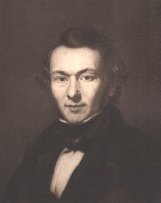 Richard
Cobden (1804 – 1865) the
radical MP whose opposition to the Opium wars is well known. In 1838 he became one of the seven founding
members of the Anti-Corn Law League in Manchester, argued
that just as “in the slave trade we have surpassed in guilt the world, so in
foreign wars we have been the most aggressive,
quarrelsome, warlike and bloody nation under the sun.” Richard
Cobden (1804 – 1865) the
radical MP whose opposition to the Opium wars is well known. In 1838 he became one of the seven founding
members of the Anti-Corn Law League in Manchester, argued
that just as “in the slave trade we have surpassed in guilt the world, so in
foreign wars we have been the most aggressive,
quarrelsome, warlike and bloody nation under the sun.”
 In October 1850 he wrote to fellow radical Joseph
Sturge (1793 - 1809) that if you looked back over the previous 25
years “you will find that we have been incomparably the most sanguinary
(bloodthirsty) nation on earth.” Whether it was “in
China, in
Burma, in
India,
New Zealand, the Cape,
Syria,
Spain,
Portugal, Greece, etc. there is hardly any country, however remote, in which we have not been
waging war or dictating our terms at the point of the bayonet. Indeed, he
believed that the British, “the greatest
blood-shedders of all”, had in this period been involved in more
wars than the rest of
Europe
put together. Colden blamed this militarism on the aristocracy that had
“converted the combativeness of the English race to its own sinister ends.”
In October 1850 he wrote to fellow radical Joseph
Sturge (1793 - 1809) that if you looked back over the previous 25
years “you will find that we have been incomparably the most sanguinary
(bloodthirsty) nation on earth.” Whether it was “in
China, in
Burma, in
India,
New Zealand, the Cape,
Syria,
Spain,
Portugal, Greece, etc. there is hardly any country, however remote, in which we have not been
waging war or dictating our terms at the point of the bayonet. Indeed, he
believed that the British, “the greatest
blood-shedders of all”, had in this period been involved in more
wars than the rest of
Europe
put together. Colden blamed this militarism on the aristocracy that had
“converted the combativeness of the English race to its own sinister ends.”
Public
opinion in Britain
was inevitably mobilized behind the war to suppress the Great Rebellion by the
atrocity stories that appeared in the press. On 30 October 1857 Lord
Shaftesbury, in a widely reported speech told of how “day by day ladies were
coming to Calcutta with their ears and noses cut off and their eyes put out”
and that children were being “put to death under circumstances of the most
exquisite torture”. The speech was immediately published as Lord
Shaftesbury’s Great Speech on Indian Cruelties. Prompted by this, Lord
Ellenborough, himself a former governor general of India, called in
the House of Lords for every man in Delhi to be castrated and for the city to be
renamed “Eunochabad” Even Charles Dickens
could long for the opportunity “to exterminate the
race upon whom the stain of the later cruelties rested…to blot it out of
mankind and raze if off the face of the earth.”
Although
privately Richard Cobden could still confess that if he were an Indian “I
would be one of the rebels” and that "Hindustan
must be ruled by those who live on that side of the globe", discretion proved
the better part of valor. He reluctantly came to accept that the rebellion had
to be put down.
Lord
Canning, the governor general, complained to Queen
Victoria
of a “rabid and indiscriminate vindictiveness”
having gripped the British in
India
. People seemed to think “that the hanging and shooting of 40 or 50,000
mutineers besides other rebels can be other wise than practicable and right.”
He confessed to “a feeling of shame for one’s fellow countrymen.
(source:
The
Blood Never Dried: A People’s History of the
British Empire - By John
Newsinger
p. 66 - 67 and 80 - 82).
***
By the middle of the nineteenth
century, the British had come to believe they were a chosen race; chosen to
distribute the benefits of western civilization to the backward areas of the
globe. That the inhabitants of such areas often didn’t want these benefits and
certainly not the accompanying British control of their lives was immaterial to
Britain’s sense of a mission. In 1857, the
Indian Mutiny broke out and it rapidly became the greatest of all the imperial
wars. It was followed avidly by the British public and as the myths of the
Mutiny grew it came to be seen almost as a latter-day British Iliad with
gentleman-warriors of homeric proportions manfully defending the position,
dignity and God-given duty of their race. It was even called the 'epic of the
Race' by the historian Sir Charles Crostwaithe
and though this may sound ridiculous to the modern ear it was nothing more than
a reflection of the confidence, indeed arrogance, with which the British of
Victoria's 20th year on the throne viewed the world in general and their empire
in particular.
For more than a year the people of northern India trembled with
fear as the British sated their thirst for revenge.
The
Indians called it 'the Devil's Wind'.
(source: The Epic of the Race: India 1857 - http://www.geocities.com/Broadway/Alley/5443/indmut.htm
)
The British retaliation against was
severe. In Delhi one eyewitness boasted that
" all the people found within the walls when our troops entered were
bayoneted on the spot...These were not mutineers but residents of the city, who
trusted to our well-known mild rule for pardon. I am glad to say they were
disappointed." At the site of the massacre of women in Cawnpore, the
British made their captives lick the dried blood off the floor before hanging
them. The war rumbled on until late in 1858, but the executions continued until
well into 1859, rebels being hanged or shot without trial, convicted mutineers
being lashed to the muzzles of guns and blown to pieces.
Lord
Canning tried in vain to curb the
"rabid and indiscriminate vindictiveness " of
his compatriots, pointing out that "the government which has punished
blindly and revengefully will have lost its chief title to the respect of its
subject."
A death sentence was passed on the
East India Company, too.
(source: Colonial
Overlords: Time Frame Ad 1850-1900 - Time-Life
Books. The Scramble for Africa p. 25-26).
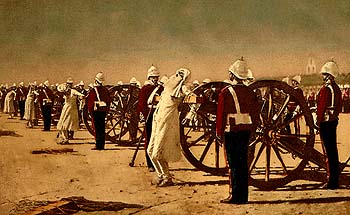
The Devil's Wind. Mutineers placed in the front of canyons to be killed.
“the
English threw aside the mask of civilization and engaged in a war of such
ferocity that a reasonable parallel can be seen in our times with the Nazi
occupation of
Europe.”
- writes Historian Michael
Edwardes.
"The Black Hole of Calcutta - episode,
embellished by Europeans and propagated as proof of native savagery, would
retroactively help to justify what came next: the conquest of Bengal and,
ultimately India. " -
(source:
Churchill’s
Secret War: The British Empire and the Ravaging of India during World War II-
By Madhushree Mukherjee
p. xii).
***
Pandit
Jawaharlal
Nehru wrote: "A great deal of false and perverted history has
been written about the Revolt and its suppression. What the Indians think about
it seldom finds its way to the printed page.
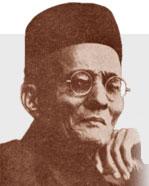 Veer
Savarkar
wrote: "The History of the War of Independence"
some thirty years ago, but his book was promptly banned. Veer
Savarkar
wrote: "The History of the War of Independence"
some thirty years ago, but his book was promptly banned.
The
book was, of course, banned in India, but still appeared "on the Indian
bookstalls, wrapped in a cover labeled Random
Papers of the Pickwick Club".
(source: The
Blood Never Dried: A People’s History of the
British Empire - By John
Newsinger
p. 72).
Neera
Kuckreja Sohoni has remarked:
"It took a Savarkar's intellectual vigour and aggressive reasoning to question
and replace the biased Anglophile historical branding of the 1857 outbreak as a
"mutiny" with the "the first war of independence"
nomenclature. "
(source: Nothing
singular in revisionism - By Neera
Kuckreja Sohoni dailypioneer.com).
The
British were not only greedy for money and for land. They wanted to Christianize
and denationalize
India
.
The
Chairman of the Court of Directors of the East India Company as
saying in the House of Commons:
"Providence
has entrusted the extensive empire of Hindustan to
England
in order that the banner of Christ should waive triumphant from one end of
India
to the other. Everyone must exert all his strength that there may be no
dilatoriness on account in continuing in the country the grand work of making
India Christian”.
Justin
McCarthy wrote: “The fact was that throughout the greater part of
northern and northwestern provinces of the Indian peninsula there was a
rebellion of the native races against the English power. It was not the sepoy
alone who rose in revolt. It was not by any means a merely military mutiny. It
was a combination of military grievance, national hatred and religious
fanaticism against the English occupation of
India
. The Mohammedans and the Hindu forgot their old religious antipathies to join
against the Christian….”
Charles Ball wrote: “At length the torrent
overflowed the banks and saturated the moral soil of
India
. The movement now assumed a more important aspect. It became a rebellion of a
whole people incited to outrage by resentment for imaginary wrongs and sustained
their delusions by hatred and fanaticism”.
Sir W. Russell,
of the London Times correspondent as writing: “Here we had not only a servile
war, but we had a war of religion, a war of race and a war of revenge, of hope,
of national determination to shake off the yoke of a stranger and to
re-establish the full power of the notice chiefs and the full away of native
religion.”
Rev
Kennedy as saying: “Whatever misfortunes come on us as long as our
empire in
India
continues, so long let us not forget that our chief work is the propagation of
Christianity in the land. Until Hindustan from Cape Comorin to the
Himalayas
embrace the religion of Christ and until it condemns the Hindu and Muslim
religions, our efforts must continue persistently”.
The Christian missionary propaganda was not only violently aggressive and
widespread; it was also supported by the government agency.
According to Kaushik
Roy writing in Economic and Political Weekly
(May12) “the number of civilians and Indian soldiers killed exceeded one lakh
(1,00,000). There was not a tree in some places which did not see a dead Indian
hanging from the branches. In comparison just about 2,034 British soldiers died
in action another 8,978 died form disease. British terrorism did not frighten
Indians.
The EPW quotes a British lady residing in
Lucknow
noting in her journal on May 16, 1857: “You
can only rule these Asiatics by fear; if they are not afraid, they snap their
fingers at you”.
(source: An
essay on 1857-II : The British were greedy for money, land and wanted to
Christianize- orgainser.org).
'A Holocaust, one where
millions disappeared...'
British reprisals involved the killing of 10m, spread over 10 years
A
controversial new history of the Indian Mutiny, which broke out 150 years ago
and is acknowledged to have been the greatest challenge to any European power in
the 19th century, claims that the British pursued a murderous decade-long
campaign to wipe out millions of people who dared rise up against them.
In
War of Civilisations:
India
AD 1857, Amaresh Misra, a writer and historian based in Mumbai,
argues that there was an "untold holocaust" which caused the deaths of
almost 10 million people over 10 years beginning in 1857.
Britain
was then the world's superpower but, came perilously close to losing its most
prized possession:
India
.
"It
was a holocaust, one where millions disappeared. It was a necessary holocaust in
the British view because they thought the only way to win was to destroy entire
populations in towns and villages. It was simple and brutal. Indians who stood
in their way were killed. But its scale has been kept a secret."
There is
a macabre undercurrent in much of the correspondence. In one incident Misra
recounts how 2m letters lay unopened in government warehouses, which, according
to civil servants, showed "the kind of vengeance our boys must have wreaked
on the abject Hindoos and Mohammadens, who killed our women and children."
Misra has done well to unearth anything in that period, when the British
assiduously snuffed out Indian versions of history. "There appears a
prolonged silence between 1860 and the end of the century where no native voices
are heard. It is only now that these stories are being found and there is
another side to the story," said Amar Farooqui, history professor at
Delhi
University
. "In many ways books like Misra's and those of [William] Dalrymple show
there is lots of material around. But you have to look for it."
(source:
'A
Holocaust, one where millions disappeared...' - guardian.co.uk).
What
Every "Ugly American" Must Know about the "Civilized British
One of the tragedies of
English-speaking British colonies is that their history under the British rule
was written by the British historians, or by those natives who were trained by
the British historians. However, it seems the time has come to record
history in its true light-- at least so in India.
Amaresh Misra, writing about India's first war of
independence in 1857, in his recently published book, In War of Civilisations:
India AD 1857, said that there was an "untold holocaust" that caused
the deaths of almost 10 million people over 10 years, beginning in 1857.
British-fed historians, claims Misra, have counted only 100,000 Indian soldiers
who were slaughtered in savage reprisals, but none have tallied the number of
rebels and civilians killed by British forces desperate to impose order.
(source: What
Every "Ugly American" Must Know about the "Civilized British
- www.larouchepac.com).
"The spread of Christianity was to cause great unease among
the Indians. Evangelical Christian missionaries had little or no understanding
and respect for
India
's ancient faiths and their efforts to convert many natives quickly brought
clashes with the local religious establishments. As the missionaries were mostly
British citizens, the Colonial Administration often had to intervene to protect
them, which naturally gave an impression of official condolence for
Christianity."
The Christian
missionaries are back to their mischief - Need
we another mutiny against the powers that be?
(source:
The
Epic of Race: The Indian Mutiny of 1857
- victorianweb.org).
Refer
to the Havoc
un leased by Christian Missionaries today to destroy India's Ancient culture in
the chapter on Conversion.
The
Devil's Wind
Unparalleled Ferocity and Torture of Indians
Michael
Edwardes has argued that during the Indian Rebellion “the
English threw aside the mask of civilization and engaged in a war of such
ferocity that a reasonable parallel can be seen in our times with the Nazi
occupation of
Europe.” This was the considered opinion of a historian who had spent his
life studying and writing about India.
In Thomas
Lowe’s Central India During The Rebellion of 1857 and 1858
he laments that the column in which he was serving had become encumbered
with prisoners. While the policy was to take no prisoners, he told his readers
that:
“We
must remember that flesh and blood – even the hardy Anglo-Saxons – cannot go
on slaying from sunrise to sunset. However willing the spirit may be, physical
force cannot endure it."
Not to worry though. On this occasion all 76 of the men taken prisoners
“were tried, sentenced and executed.” They were “ranged in one long line
and blindfolded” with their executioners positioned “couple of yards” in
front of them. When the bugle sounded “a long rattle of musketry swept this
fleshy wall of miscreants from their earthly existence”. Lowe himself
acknowledges how “terrible” the scene was.
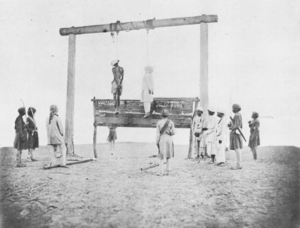
Mutineers
hanged
This
was not an exceptional occurrence. It was routine, repeated on numerous
occasions, sometimes with fewer victims, sometimes more, often with greater
brutality.
***
This
was not an exceptional occurrence. It was routine, repeated on numerous
occasions, sometimes with fewer victims, sometimes more, often with greater
brutality. The violence with
which the British put down the Indian Rebellion has only been approached in the
history of the empire by the suppression of the United Irish rebellion in the
1790s and of the Mau Mau rebellion in the 1950s.
According
to Karl Marx writing in 1853, the British
had “a double mission in India: one destructive, the other regenerating”. They had accomplished the
destructive in a way that unveiled before our eyes "all
the profound hypocrisy and inherent barbarism of bourgeois
civilization…turning from its home, where it assumes respectable forms, to the
colonies, where it goes naked.”
Writing
about the outbreak of the Great Rebellion, he discussed “the official Blue
Books on the subject of East India torture, which was laid before the
House of Commons during the seasons of 1856 and 1857”.
These reports established “the universal existence of torture as a financial
institution of
British India
.”
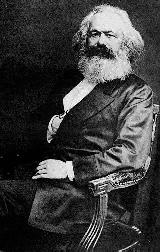 Karl
Marx pointed out: Karl
Marx pointed out:
“From
the real history of British rule in India. In view of such facts, dispassionate and thoughtful men may perhaps be led to
ask whether a people are not justified in attempting to expel the foreign
conquerors who have so abused their subjects.”
What did
this torture involve? It ranged from rough manhandling through flogging and
placing in the stocks and then on to more extreme measures:
“Searing
with hot irons….dipping in wells and river till the victim is half
suffocated…squeezing the testicles…putting pepper and red chillies in the
eyes or introducing them into the private parts of men and women….prevention
of sleep…nipping the flesh with pincers…suspension from the branches of a
tree..imprisonment in a room used for storing lime..”
What
is remarkable is how little this regime of torture has figured in accounts of
British rule in India.
It is a
hidden history that has been unremarked on and almost completely unexplored.
Book after book remains silent on the subject. This most surely calls into
question the whole historiography of the Raj. One last point is worth noting
here: the extent to which everyday relations between the British and Indian
subjects were characterized by abuse and violence. Servants were routinely
abused as “niggers” and assaulted and beaten by their masters, something
that worsened during and after the Great Rebellion.
Lord
Elgin (1811- 1863) writing in August 1857, described British feelings
towards the Indians as consisting of “detestation,
contempt, ferocity.” This everyday abuse and violence continued until the end
of the British Raj.
(source: The
Blood Never Dried: A People’s History of the
British Empire - By John
Newsinger
p. 65 - 71).
 According to the great historian
R.
C. Majumdar the activities of Christian missionaries was a major
contributor to the great uprising of 1857: According to the great historian
R.
C. Majumdar the activities of Christian missionaries was a major
contributor to the great uprising of 1857:
“The sensitiveness of the sepoys to their religious beliefs
and practice and the dread of conversion to Christianity worked as a nightmare
upon their minds….A vague dread that the government was determined, by hook or
by crook, to convert the Indians to Christianity pervaded all ranks of society,
and the sepoys, fully shared these apprehension with the rest…The
aggressive attitude of the Christian missionaries …in matters of
proselytization has been frequent subjects of complaint.”
Among
such aggressive activities, Majumdar noted the practice of missionaries of
"open unchecked denunciation of their cherished social usages and customs
in most violent language, and filthy abuses of their gods and goddesses by bands
of Christian missionaries."
(source:
Christianity's Scramble for India and The Failure of
The Secularist' Elite - By N S Rajaram Hindu Writers Forum 1999 New
Delhi. p. 38-39).
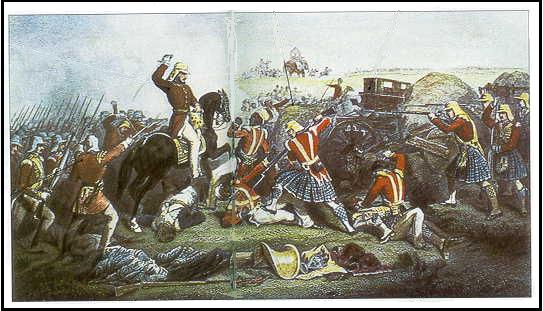
This lithograph shows the
pitched battle during the first war of independence - 1857.
In 1877 Queen Victoria
took the title of Empress of India on the advice of her Prime Minister,
Benjamin Disraeli.
***
In
my own city and district of Allahabad and in the neighborhood, General
James Neill (1810 - 1857) held his ' Bloody Assizes.' Soldiers and civilians alike were holding Bloody
Assize, or slaying natives without any assize at all, regardless of age or sex.
It is on the records of our British Parliament, in papers sent home by the
Governor-General in Council, that "the aged, women, and children are
sacrificed as well as those guilty of rebellion." They were not
deliberately hanged, but burnt to death in villages - Volunteer hanging parties
went into the districts and amateur executioners were not wanting to the
occasion. One gentleman boasted of the numbers he had finished off quite
"in an artistic manner," with mango trees as gibbets and elephants for
drops, the victims of this wild justice being strung up, as though for pastime,
in the form of figures of eight.
British
memorials of the Mutiny have been put up in Cawnpore and elsewhere. There is no
memorial for the Indians who died.
(source:
The
Discovery of India - By Jawaharlal Nehru p. 324-325).
Indian JNU historians and Negationism
In
spite of Islamic Onslaught and British
Imperialism, our children should read
what the West Bengal's leftist government is
teaching kids. Refer to an extract from the, textbook for Class V.
"Islam and Christianity are the only religions which
treated man with honor and equality..."
(source: Does
Indian history need to be rewritten? Times of India 12/02/01 http://www.hvk.org/articles/1206/69.html).
Refer
to Eminent
Historians: Their Technology, Their Line, Their Fraud.
Claude
Alvares has written: "The English establishment themselves as a
separate ruling caste; like other Indian castes, they
did not inter-marry or eat with the lower (native) caste. Their
children were shipped off to public schools in England, while they themselves
kept to their clubs and bungalows in special suburbs known as cantonments and
civil lines."
(source: Decolonizing
History: Technology and Culture in India, China and the West 1492 to the Present
Day - By Claude Alvares p. 191).
  
Page < 1 2 3 4 5 6 7 8 9 10 11 12 13 14 15 16 17 18 19 20 21 22 23 24 >
|